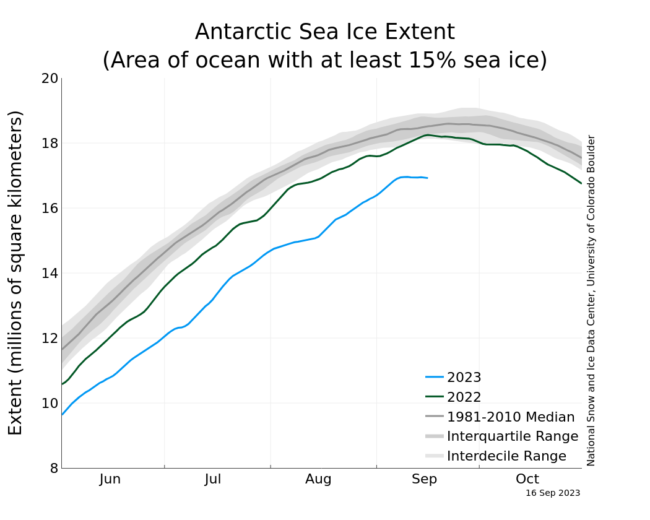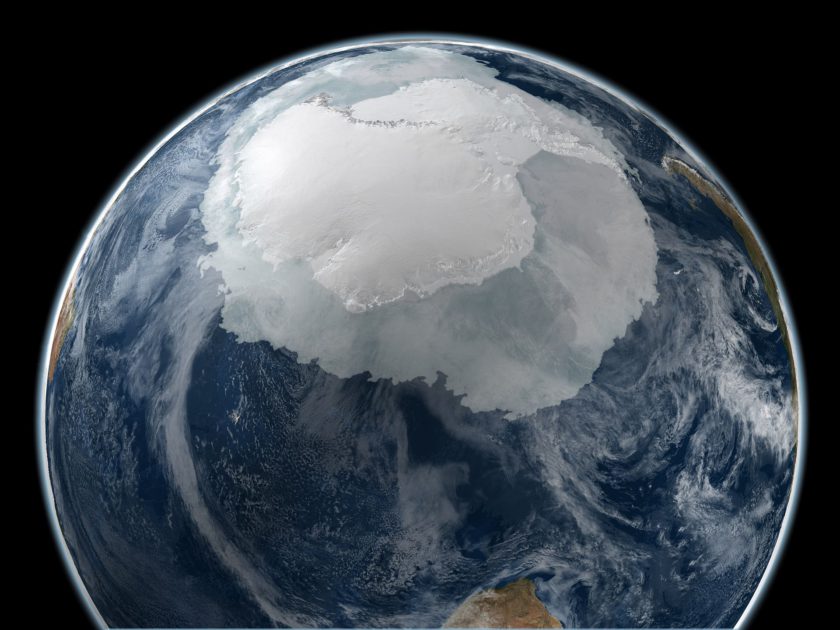
The word “record breaking” is really not a turn of phrase you want to hear when it comes to climate change, and yet here we are. This has been applied, not just to one or two things, but rather disturbingly, to rather a lot of recent events. Now, here we are with one more shattered record to add to that collection. It is the current decline of the sea ice within the Antarctic. Taken together with all the other broken records, it all adds up to at rather strong red-flag warning that we as a species are in serious trouble.
Have enough decision makers got the message yet?
Antarctic Sea Ice
We have very precise daily measurements of the extent of the sea ice around the Antarctic, and right now … well I need not say it, because you can guess the next bit …

The green line above is last year.
For context, the gray reveals the averages measured between the start of the satellite record in 1981 and 2010.
The blue line is this year. What it reveals is a record low for sea-ice extent.
Last year for quite some time the green line was well below average, but by the time we got to the time of year for peak sea-ice extent t had more or less slid into being average … ish. This year, well yes, you can see for yourself, Its a different story, one that has the subject matter experts freaking out.
Well below last year’s line.
We are not yet at the official end of sea ice growth, ut we are close enough to call it with a degree of confidence.
Here is a different way to visualise the same data …

Within the above you can see the vast gaps between the yellow line, which is the average extent and where the sea ice is now.
The Feedback loop
The Antarctic winter, March to October, is when the sea ice forms. We are now transitioning into the Antarctic spring and face a potentially unstoppable feedback loop. Ice is of course white, and so having vast amounts of it on the sea surface enables it to act like a mirror that reflects solar energy away from the planet. However, when that ice goes, you have a dark ocean surface that will instead absorb that energy.
More energy captured means more sea ice melt, which in turn means … well yes, you get it. This is the potential feedback loop.
Let me put this another way for you. The Antarctic plays a role of being the regulator of global temperatures. Think of it as our global fridge to keep things cool. This is now being disrupted, and we are turning our fridge into a radiator.
That seriously not cool … literally.
But what does this all mean, where is this heading?
There is a recent scientific paper worth mulling over.
Paper: Record low Antarctic sea ice coverage indicates a new sea ice state
Link.
The abstract for the paper published on Sep 13 within Nature Communications Earth & Environment, reads …
In February 2023, Antarctic sea ice set a record minimum; there have now been three record-breaking low sea ice summers in seven years. Following the summer minimum, circumpolar Antarctic sea ice coverage remained exceptionally low during the autumn and winter advance, leading to the largest negative areal extent anomalies observed over the satellite era. Here, we show the confluence of Southern Ocean subsurface warming and record minima and suggest that ocean warming has played a role in pushing Antarctic sea ice into a new low-extent state. In addition, this new state exhibits different seasonal persistence characteristics, suggesting that the underlying processes controlling Antarctic sea ice coverage may have altered.
It is of course rather obvious stuff. Warming oceans leads to sea ice melt … well duh!. OK, while that sounds simple, it is also all rather complicated, and yet in the end it really does appear to be down to the warming oceans.
Also, that feedback loop I mentioned does indeed play a big role …
…This relationship can be understood in terms of persistence, via the ice-albedo and ocean heat uptake feedbacks, whereby higher sea ice coverage in spring increases the albedo and reduces solar ocean warming in subsequent months, leading to a cooler surface ocean and higher sea ice coverage into summer…
The case that the paper makes is that from about 2016 onwards the entire Antarctic sea ice system rapidly transitioned to a new, low sea ice state.
Yes, but what does this lead to?
To be brief and specific, here is a list …
- Basal melting beneath ice shelves
- Greater coastal exposure will increase coastal erosion and reduce ice-shelf stability
- Changes in dense shelf water production will alter bottom water formation and deep ocean ventilation
- Sea ice changes will also have contrasting influences on Adélie and emperor penguin colonies
Are you actually Surprised by this?
Climate models predicted this as an inevitable consequence.
No really, they did …
Fox-Kemper, B., et al. Ocean, Cryosphere and Sea Level Change. In Climate Change 2021: The Physical Science Basis. Contribution of Working Group I to the Sixth Assessment Report of the Intergovernmental Panel on Climate Change [Masson-Delmotte, et al. (eds.)]. Cambridge University Press, Cambridge, United Kingdom and New York, NY, USA, 1211–1362, (2021).
We really do not want to see all that ice in the Antarctic melt.
Why?
Well because if the 7.3 million cubic miles of Antarctic ice did all melt, then it is worth understanding that this is enough ice to raise sea level by about 60 meters. That’s enough to wipe out every major costal city and also totally obliterate Florida and Louisiana, because both those states have an average height above sea level of just 31 meters.
We still have choices
We are already committed to rather a lot of consequences that can no longer be avoided.
The one choice we do have that that we can determine the speed at which it all unfolds.
We must reduce greenhouse gas emissions. If we can do so rapidly, then we can potentially lengthen the timescales that this all unfolds over. If it all happens too rapidly, then we will not be able to adapt. Slowing consequences down to a far longer timescale gives us a shot at being able to adapt.
What is inevitable is that at some point our greenhouse gas emissions will be rapidly reduced. I’d far rather see it as a choice we make and not simply a consequence of our species being obliterated.
Subject Matter Expert Quotes
“Are we awakening this giant of Antarctica?” asks Prof Martin Siegert, a glaciologist at the University of Exeter. It would be “an absolute disaster for the world,” he says.
There are signs that what is already happening to Antarctica’s ice sheets is in the worst-case scenario range of what was predicted, says Prof Anna Hogg, an Earth scientist at the University of Leeds.
…
“It’s potentially a really alarming sign of Antarctic climate change that hasn’t been there for the last 40 years. And it’s only just emerging now.”
